In the realm of philanthropy, donor appreciation gifts stand as heartfelt symbols of gratitude for generous contributions. These tokens, though often understated, play a crucial role in maintaining and nurturing the bond between organizations and their benefactors. Dive into this article to explore the profound impact of these gestures and the innovative ways they can be presented.
Why is Giving Back to Nonprofit Donors Important?
The act of giving to nonprofit organizations is driven by a donor’s belief in a cause, a desire to make a positive difference, or personal experiences that align with the mission of the organization. For nonprofits, these donors form the backbone of their operations, enabling them to pursue their objectives and make a lasting impact in the communities they serve. Recognizing and giving back to these donors, therefore, becomes crucial for several reasons:
1 – Fostering Stronger Relationships
At its core, the relationship between a donor and a nonprofit is based on trust and shared values. By giving back in the form of acknowledgment or appreciation, nonprofits can strengthen this bond. The simple act of recognizing a donor’s contribution can deepen their connection to the cause and the organization.
2 – Encouraging Continued Support
Donor retention is a significant concern for many nonprofits. Research indicates that it’s more cost-effective to retain an existing donor than to acquire a new one. By showing appreciation and giving back, nonprofits can motivate donors to continue their support, ensuring a more stable stream of funding.
3 – Building a Community
When donors feel appreciated and acknowledged, they are more likely to become ambassadors for the cause, promoting the organization within their networks. This can lead to a domino effect, encouraging others to support the nonprofit, thereby expanding its community of supporters.
4 – Positive Public Perception
In today’s digital age, word of mouth travels fast. When donors have positive experiences with an organization – including feeling appreciated – they are likely to share their stories on social media and with friends and family. This can enhance the organization’s reputation and attract more support.
5 – Ethical Responsibility
Beyond strategic reasons, there’s an ethical dimension to acknowledging donors. They have chosen to part with their hard-earned money to support a cause they believe in. It’s only right for nonprofits to show gratitude and respect for this act of kindness and selflessness.
6 – Enhancing Future Fundraising Efforts
When donors feel recognized and valued, they are more likely to increase their future donations or even participate in other fundraising activities, such as events or campaigns. This not only boosts immediate funds but can also open doors to larger grants or partnerships.
What to Avoid When Choosing Donor Appreciation Gifts
Selecting the right appreciation gift for nonprofit donors is an art, balancing meaning with practicality. While it’s essential to express gratitude, it’s equally crucial to avoid pitfalls that can diminish the gesture’s impact or even offend a donor. Here are some common missteps to steer clear of when choosing donor appreciation gifts:
1 – Overly Expensive Gifts
While you want to express gratitude, gifting items that are too lavish can send the wrong message. Donors might wonder if their contributions are being used judiciously or if their money is going towards unnecessary expenses.
2 – Generic Gifts
Donors appreciate personalized recognition. Avoid generic items that lack a personal touch. Gifts that resonate with the mission of the nonprofit or the donor’s specific interests will be more impactful.
3 – Cultural Insensitivity
It’s crucial to be aware of the cultural, religious, or personal preferences of donors. An item that might be a cherished gift in one culture could be offensive or meaningless in another.
4 – Environmental Unfriendliness
In today’s eco-conscious world, gifting items that are not environmentally friendly can be seen in a negative light. Avoid plastic trinkets or other non-biodegradable items that can harm the environment.
5 – Ignoring Dietary Restrictions
If you’re considering edible gifts, be sure to account for dietary restrictions, allergies, or religious constraints. The last thing you want is for a donor to receive a gift they cannot consume.
6 – Complexity and Impracticality
While novelty gifts can be fun, if they are too complicated or have no practical use, they might end up discarded or unused. Opt for gifts that are straightforward and can be easily integrated into the recipient’s life.
7 – Over-branding
While it’s natural to want to promote your nonprofit, avoid turning the appreciation gift into a blatant promotional item. A subtle logo or mention is acceptable, but the primary focus should be on the gesture of gratitude.
8 – Ignoring Feedback
If donors have previously given feedback about certain types of gifts or have expressed preferences, it’s essential to take note and act accordingly. Ignoring such feedback can make donors feel undervalued.
9 – One-size-fits-all Approach
Remember that donors come from various backgrounds and have different preferences. While it might be challenging to cater to each individual, try to have a range of gifts that cater to different tastes and preferences.
10 – Lack of Follow-up
Simply sending a gift is not enough. It’s essential to follow up with a personal note or message, expressing gratitude and explaining the significance of the gift. This adds a personal touch and reinforces the bond between the donor and the organization.
In essence, donor appreciation gifts should be chosen with care, keeping the donor’s preferences and the organization’s values in mind. Avoiding these pitfalls will ensure that your gesture of gratitude is received in the spirit it was intended and strengthens the relationship with your valued supporters.
Crafting a Data-Driven Donor Appreciation Approach
At the heart of an effective donor appreciation strategy lies insightful data. Leveraging this data not only guides you in tailoring your appreciation initiatives but also in molding messages that genuinely touch your supporters.
To embark on this journey, begin by diving deep into your donor database. This will ensure that your messages are precisely targeted, hitting the right chord with your supporters.
Understanding Your Donor Demographics
With a robust donor management system, particularly one focused on retaining donors, you can extract critical information about your supporters. This data helps in tailoring an appreciation message that aligns with their sentiments. Recognize the various segments within your donor base and determine the appropriate appreciation tactics for each. For instance, while a recognition plaque might be apt for long-standing supporters, a personalized thank-you note could suffice for new donors.
As you draft your appreciation blueprint, it’s essential to have nuanced strategies for each segment of your audience.
Tailoring Your Appreciation Techniques
Post your demographic analysis, and strategize on the appreciation techniques best suited for each donor segment. For example:
- When segmenting by donation size, distinct appreciation methods can be employed for high-value donors compared to those making smaller contributions. Remember, with larger donations come fewer donors, allowing for more personalized appreciation gestures.
- Segmenting by donation frequency allows you to devise unique appreciation methods for new donors in comparison to regular contributors. A strategy for first-time donors might focus on encouraging a subsequent donation, with appreciation shown promptly.
- Segregating donors by age can help tailor appreciation gestures. Younger donors might resonate more with a digital shout-out on social platforms, while older supporters could value a traditional handwritten note.
The ultimate objective is to refine your appreciation methodology based on each donor’s preferences and history with your organization.
The Essence of Gratitude
At its core, this entire endeavor is about expressing gratitude. Whether it’s a token of appreciation or a name on a recognition wall, it should always be accompanied by a heartfelt acknowledgment of their contribution. The message should be intimate, addressing the donor personally and highlighting their specific contribution. For instance:
Dear Alex, your generous gift of $100 to the Ocean Conservation initiative will ensure medical care for 10 rescued dolphins this week!
Such messages underscore the specific impact of the donor’s contribution, reinforcing the tangible difference they’re making.
Highlighting the Impact
Illustrating the real-world effects of a donation is paramount. Donors are driven by the desire to make a difference, and showcasing how their contribution directly influences the cause amplifies their connection with the mission. By transparently conveying the impact, donors can see that their generosity isn’t just funding your organization but actively advancing its cause.
In essence, the key to a successful donor appreciation strategy is understanding, personalization, and genuine gratitude, all underpinned by insightful data.

Best Nonprofit Donor Appreciation Gifts
When expressing gratitude to donors, a carefully chosen appreciation gift can resonate profoundly, reiterating the significance of their contribution. Let’s delve deeper into some standout donor appreciation gifts and explore why they leave a lasting impression:
1 – Personalized Thank You Letters
These letters, when crafted with care, resonate deeply by highlighting specific impacts of a donor’s contribution. By weaving in personal stories or sharing beneficiary testimonials, such letters underscore the tangible difference every donation makes, fostering a more profound emotional bond.
2 – Branded Merchandise
High-quality, practical items like tote bags or mugs serve a dual purpose. They offer everyday utility while subtly promoting the nonprofit’s cause. When donors use or display these items, they’re not just reminded of their contribution but also become ambassadors, sparking conversations about the mission.
3 – Handmade Crafts
Handcrafted items from beneficiaries establish a direct link between donors and those they support. These tangible tokens, be it pottery or textiles, encapsulate the skills and talents nurtured by contributions, making the impact of donations palpable.
4 – Books Related to the Cause
A well-selected book can expand a donor’s understanding and commitment. By deepening their knowledge and empathy towards the cause, such gifts create a more informed and engaged supporter.
5 – Event Invitations
Inviting donors to exclusive events offers them an immersive experience. Witnessing the organization’s work firsthand, interacting with beneficiaries, or mingling with like-minded supporters can amplify their connection and dedication to the cause.
6 – Plantable Items
Seeds or plantable stationery represent growth, hope, and renewal. As the donor nurtures these plants, they’re symbolically nurturing the cause, creating a daily reminder of the positive change they’re part of.
7 – Photo Books or Calendars
A curated collection of photographs provides a visual journey through the nonprofit’s milestones. Each image, with its accompanying narrative, paints a vivid picture of the change effected, making the donor’s role in that journey evident.
8 – Virtual Experiences
Offering donors a digital window into the nonprofit’s operations can be both enlightening and engaging. It showcases transparency, allows real-time interactions, and reinforces the importance of their continued support.
9 – Recognition Plaques or Certificates
A permanent acknowledgment like a plaque serves as a testament to a donor’s generosity. Displayed prominently, it’s a daily reminder of their invaluable role and the appreciation the organization feels.
10 – Subscription Boxes
Curated subscription boxes offer an ongoing connection. The periodic arrival of stories, updates, and themed items keeps the mission front and center in a donor’s mind, reinforcing their impact and the nonprofit’s gratitude.
11 – Exclusive Content
Providing an insider’s view through specialized content fosters trust and closeness. It not only acknowledges a donor’s significance but also deepens their understanding and engagement with the mission.
12 – Workshops or Classes
Specialized sessions tap into the expertise of the nonprofit, offering donors not just a learning experience but also a deeper appreciation of the intricacies of the cause they support.
Conclusion
Donor appreciation gifts are pivotal in reinforcing the bond between nonprofits and their supporters. Thoughtfully chosen, these tokens not only express gratitude but also underline the profound impact of each contribution. It’s through such meaningful gestures that enduring philanthropic relationships are built and nurtured.



